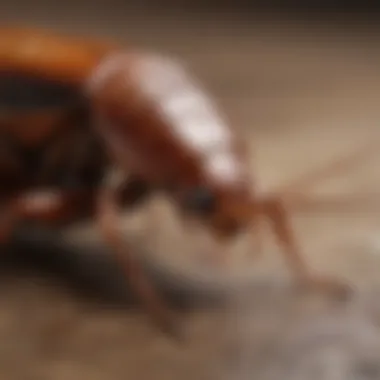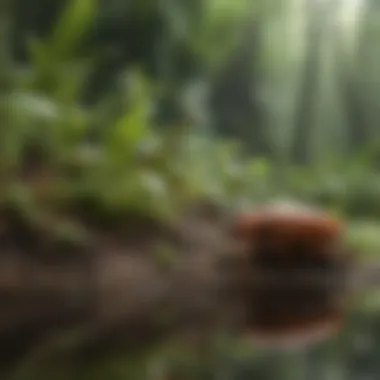Distinguishing Roaches from Waterbugs: An In-Depth Guide


Intro
Understanding the distinctions between roaches and waterbugs is essential for effective pest management and ecological awareness. Both insects are frequently misidentified, leading to confusion in handling infestations. This article provides clarity by examining their biological classifications, physical features, habitats, behaviors, and the implications that arise from these differences. Homeowners and enthusiasts alike will benefit from the insights offered here, as they will be better equipped to manage these pests appropriately.
Key Differences
Recognizing roaches and waterbugs requires an understanding of their unique traits. Roaches, or cockroaches, are typically smaller, with a flattened oval shape and a characteristic brown to black coloration. In contrast, waterbugs can be significantly larger, possessing a broad, flat body with a more elongated shape, often brown or black as well. Their presence is also determined by their preferred habitats – roaches thrive in warm, moist environments such as kitchens, while waterbugs favor aquatic settings and damp areas.
Here, we highlight some key distinctions:
- Size: Waterbugs are generally larger than most roach species.
- Habitat: Roaches prefer indoor environments; waterbugs are usually found near water sources.
- Behavior: Roaches are nocturnal scavengers; waterbugs, while also nocturnal, have specific aquatic habits.
"Awareness is the first step toward safeguarding your home from infestations."
By understanding these fundamental differences, readers can identify which pest they are dealing with and take the relevant pest control measures.
Why Identification Matters
Correctly distinguishing between roaches and waterbugs is not merely an academic exercise. Treatment strategies vary significantly, as do the ecological implications. Utilizing improper methods can lead to ineffective management or exacerbate the problem. For instance, applying a pesticide designed for roaches on waterbugs may accomplish little and can potentially harm non-target species in the vicinity. It is vital, therefore, to know which pest is being dealt with before taking action.
In the forthcoming sections, we shall delve deeper into their biological classifications, explore their habitats and behaviors, and provide strategies for managing these pests effectively. This comprehensive analysis aims to enhance your understanding, leading to sound decision-making in pest management.
Prelude to Household Pests
The significance of understanding household pests cannot be overstated, particularly when it comes to effective management. Pests such as roaches and waterbugs have a considerable impact on the health and comfort of homes. They not only possess the potential to disrupt one's living environment but can also pose health risks. This article provides an in-depth look into these insects, focusing on their biological, physical, and behavioral distinctions. By delineating the attributes of roaches and waterbugs, this analysis aids homeowners in making informed choices about pest management.
Common Household Insects
Household insects are varied and numerous, encompassing a range of species that people often encounter. Among the most notorious are cockroaches and waterbugs, both of which are misunderstood. Cockroaches are often viewed as merely nuisances, yet they can trigger allergies and asthma. Waterbugs, on the other hand, might be mistaken for roaches due to their appearance, amplifying the confusion.
- Cockroaches: These insects thrive in warm environments and are mainly nocturnal. They can multiply quickly, making infestations challenging.
- Waterbugs: Despite their name, they are actually not true bugs but belong to a different classification. They are often found near water sources and may enter homes during warm seasons.
Knowing about these common insects is crucial for proper identification and understanding of pest behaviors.
Pest Control Overview
Understanding pest control is vital for maintaining a healthy living space. It involves the methods employed to prevent, manage, and eliminate pests. Effective pest control requires an awareness of the behavior and habitat of the insects in question. With cockroaches and waterbugs, different techniques may need to be applied as their biology and needs vary significantly.
- Prevention: Homeowners should focus on habitual practices such as sealing entry points, reducing moisture, and maintaining cleanliness; these measures deter both roaches and waterbugs.
- Identification: Knowing how to accurately identify whether the pest is a roach or a waterbug facilitates appropriate treatment options.
Defining Roaches
Defining roaches is crucial in understanding the broader context of pest management. These insects often evoke fear in homeowners due to their potential health risks and infestation issues. By clearly distinguishing roaches from other similar pests like waterbugs, we enable effective communication regarding identification and treatment strategies. This section provides a detailed breakdown of roaches’ scientific classification, physical traits, habitat preferences, and behavior, offering insights that help in detection and control measures.
Scientific Classification of Roaches
Roaches belong to the order Blattodea, which also includes termites. Understanding their classification allows for proper identification of various species that may invade homes. There are about 4,600 described species of cockroaches, but only a few are considered pests. Common house roaches include the German cockroach, American cockroach, and Oriental cockroach. Each species exhibits unique characteristics that can help in distinguishing them from waterbugs.
Physical Characteristics
Size
The size of roaches varies significantly across different species. Most household roaches range from 1 to 3 inches in length. For instance, the German cockroach is about 1.1 to 1.6 inches long, while the American cockroach can grow up to 4 inches. The significant range in size impacts their visibility and how they can infiltrate spaces within a home. Understanding their size helps homeowners recognize potential infestations earlier.
Color
Roaches present a variety of colors, from dark brown to light tan. The German cockroach typically features a light brown body with two parallel stripes, making it easily recognizable. On the other hand, the American variety has a reddish-brown hue. Recognizing these color differences aids in identification, essential for selecting the right pest control methods.
Body Structure
Roaches possess a flat, oval body shape that facilitates their movement in tight spaces. They have long antennae and spiny legs, which contribute to their agility. The flatness is advantageous as it allows them to hide well in narrow gaps, complicating detection. Knowledge of their body structure assists homeowners in understanding how roaches can occupy even the smallest hiding spots.


Habitat and Behavior
Preferred Environments
Roaches thrive in warm, humid conditions. They tend to inhabit kitchens, bathrooms, and areas with food and water sources. Additionally, they often seek shelter in dark corners, cracks, and crevices. This affinity for certain environments underscores the importance of maintaining cleanliness and proper food storage to deter them.
Feeding Habits
Roaches are omnivorous scavengers. They feed on a variety of organic matter, including crumbs, grease, and even soap. Understanding their feeding habits aids in implementing effective prevention strategies. For instance, sealing food containers and maintaining a clean kitchen can significantly reduce food sources for these pests.
Life Cycle
Roaches undergo a hemimetabolous lifecycle, which consists of three stages: egg, nymph, and adult. A female cockroach can lay up to 40 eggs at once, leading to rapid population growth if not controlled. Recognizing their life cycle is critical, as it informs control measures and underscores the need for ongoing management efforts to prevent reinfestations.
Understanding Waterbugs
Understanding waterbugs is crucial in differentiating them from roaches. Waterbugs are not just another pest to deal with; they play a specific role in their ecosystems and have distinctive characteristics that are often misunderstood. Recognizing these traits helps homeowners accurately identify these insects and implement appropriate pest management strategies.
Scientific Classification of Waterbugs
Waterbugs belong to the order Hemiptera and are primarily classified under the family Belostomatidae. This classification is significant as it informs us about their evolutionary traits and behaviors. Unlike roaches, which belong to the order Blattodea, waterbugs share more characteristics with other aquatic insects, which helps in understanding their habitat and feeding preferences.
Physical Characteristics
Size
Waterbugs can vary in size, typically ranging from one to four inches in length. This size enables them to thrive both in water and on land, making them effective predators. Their size is a key characteristic in this article, helping distinguish them from smaller insects. Larger waterbugs tend to be more visible, which can be beneficial when identifying them during pest inspections.
Color
The color of waterbugs is also distinct, often displaying a brown or dark green hue. This coloration provides excellent camouflage in their natural habitats, allowing them to blend in with muddy or grassy environments. The key feature of their color is that it aids in their predatory lifestyle, making it easier to lurk undetected, thus supporting their role in the ecosystem.
Body Structure
Waterbugs possess a flat, oval-shaped body, which is a notable aspect of their physical structure. This shape allows for easy movement through water and tight spaces. Compared to the more cylindrical bodies of roaches, waterbugs appear more streamlined. Their body structure contributes to their swimming and foraging abilities, highlighting their adaptation to both aquatic and terrestrial environments.
Habitat and Behavior
Preferred Environments
Waterbugs are often found in freshwater bodies like ponds and streams. They prefer warm environments with plenty of vegetation. This preference for specific habitats is essential for readers to know, as it highlights where waterbugs tend to thrive. Knowing these environments helps in predicting where they may be encountered, thereby facilitating effective pest management.
Feeding Habits
Waterbugs are carnivorous, primarily preying on smaller insects and sometimes even small fish. Their feeding habits contribute to their role in the food chain, controlling populations of other insects. As homeowners become familiar with these traits, they can better understand the ecological implications of having waterbugs nearby, which, while unsettling, can provide benefits to the local ecosystem.
Life Cycle
The life cycle of waterbugs includes three main stages: egg, nymph, and adult. Waterbug eggs are often laid on vegetation or submerged surfaces. Nymphs resemble miniature adults and undergo multiple molts before reaching maturity. This reproductive strategy is significant, as understanding the life cycle allows for better timing in pest control measures. Synchronized treatment with the life stages of waterbugs can enhance management effectiveness and minimize re-infestation.
"Recognizing the specific traits of waterbugs not only aids in proper identification but also emphasizes their ecological roles, which can alter perceptions of these pests."
By deeply examining waterbugs, readers can gain a clearer understanding of these creatures and differentiate them from similarly appearing pests, particularly roaches. This knowledge benefits homeowners by informing pest management decisions and improving the overall effectiveness of any control measures employed.
Key Differences Between Roaches and Waterbugs
Understanding the differences between roaches and waterbugs is essential for effective pest management. Homeowners, in particular, need to identify these insects correctly to apply suitable control measures. Misidentifying these pests can lead to ineffective treatments, wasted time, and resources. This section discusses important aspects such as biological classification, physical distinctions, behavioral analysis, and habitat preferences. By evaluating these elements, readers can gain insights that inform their pest control strategies, reducing frustration and improving outcomes.
Biological Classification
Roaches belong to the order Blattodea, which includes several species commonly found in households. In contrast, waterbugs are part of the family Belostomatidae within the order Hemiptera. This classification highlights the taxonomic differences between these insects. Understanding their genetic relationships can provide context on their behaviors and habitats, helping to clarify the reasons behind their presence in homes.


Physical Distinctions
Size Comparison
Size is a distinguishing factor between roaches and waterbugs. Roaches typically vary in size from around half an inch to over two inches long, depending on the species. Waterbugs, on the other hand, can reach sizes up to four inches. This larger size may be alarming for homeowners encountering waterbugs. Knowing the size range of both insects aids in quick identification, helping to inform pest control measures promptly.
Color Variations
Color also varies significantly between these two types of insects. Roaches often exhibit brown or black hues, which allows them to blend into dark environments. Waterbugs are usually darker, featuring shades like brown or black with a glossy finish. This color variability can be useful for identification, as it contributes to their different behaviors and habitat preferences. Homeowners should be aware of these color traits when assessing infestation levels.
Body Shapes
The body shapes of roaches and waterbugs are different. Roaches have a more flattened, oval shape, which enables them to hide effectively in small crevices. In contrast, waterbugs possess a more elongated and streamlined body, which aids in swimming. These physical characteristics influence how each pest operates in its environment, making identification easier for those managing pest control practices.
Behavioral Analysis
Movement Patterns
Movement patterns differ between roaches and waterbugs. Roaches are known for their quick, darting movements, especially when disturbed. This behavior can be unsettling for homeowners. Waterbugs, however, tend to move more deliberately and can swim efficiently. Understanding their movement patterns helps in anticipating their locations and implementing control strategies effectively.
Feeding Differences
Feeding habits also distinguish these pests. Roaches are omnivorous, scavenging for various food sources, including crumbs and organic matter. Waterbugs primarily prey on other insects and small aquatic animals. Recognizing these feeding preferences can inform homeowners on how to manage food sources, reducing the likelihood of attracting either insect.
Habitat Preferences
Indoor vs Outdoor
Roaches generally prefer indoor settings, attracted to warm, humid areas such as kitchens and bathrooms. Waterbugs typically dwell outdoors, often found near ponds or streams. This understanding of habitat preferences can guide homeowners in locating potential entry points and nesting sites, leading to targeted prevention methods.
Water Dependency
Waterbugs have a strong dependency on water environments, which affects their presence in homes. Roaches, while they thrive in moist areas, do not require water bodies for survival. This distinction is crucial for pest control, as it determines the likelihood of encounter based on the surrounding environment.
Differentiating between roaches and waterbugs is not just about identifying pests. It is about understanding their habits and habitats for effective management in our homes.
Ecological Roles and Impact
Understanding the ecological roles of both roaches and waterbugs is key to grasping their significance within various environments. Each species contributes uniquely to the ecosystem, influencing not only their immediate habitats but also broader ecological interactions. Recognizing these roles can inform pest management strategies, guiding homeowners and enthusiasts in respectful and effective coexistence with these creatures.
Role of Roaches in Ecosystems
Roaches play a critical part in breaking down organic matter. As scavengers, they consume decaying plant material and food waste, contributing to nutrient cycling. Their activity helps enrich the soil, promoting plant health. In ecosystems, roaches serve as prey for numerous predators, including birds and small mammals. This positions them as an integral component of the food web, providing energy and nutrients for various species.
Moreover, roaches have adapted to diverse habitats. They thrive in urban environments, effectively managing waste through their natural behaviors.
Role of Waterbugs in Ecosystems
Waterbugs, unlike roaches, reside primarily in aquatic settings, contributing to the health of water bodies. They function as both predators and prey in their ecosystems. Waterbugs feed on various organisms, including insects, amphibians, and small fish, helping maintain balance within aquatic populations. Their presence can indicate a healthy ecosystem, as they are sensitive to pollution and environmental changes.
Additionally, waterbugs play a role in nutrient cycling within aquatic ecosystems. They break down organic material from dead plants and animals, thus supporting the overall health of their habitat.
The contributions of both roaches and waterbugs highlight the intricate connections within ecosystems, emphasizing that even commonly misunderstood pests have essential ecological roles.
By acknowledging the ecological impact of these insects, homeowners can make informed decisions on managing them, prioritizing methods that respect their roles within the ecosystem.
Common Misconceptions
Understanding the common misconceptions surrounding roaches and waterbugs is crucial. Misidentifying these insects can lead to incorrect pest management practices. This section aims to clarify prevalent misunderstandings to aid homeowners in making informed decisions.
Confusion Between the Two Species


One of the primary issues homeowners face is the visual similarity between roaches and waterbugs. Many people often mistake one for the other. They share certain features, such as a similar size and shape. It is essential to recognize the signs that can help distinguish them.
Roaches, particularly the German cockroach, are smaller and tend to be more numerous in indoor settings. Their color ranges from light brown to black. Waterbugs, on the other hand, are generally larger and often found near water sources. They have a more flattened body, making them look distinct.
Because of this confusion, people may apply waterbug treatments to roach problems and vice versa. This misapplication can lead to ineffective pest control, prolonging infestations and causing unnecessary stress for homeowners.
Myths About Infestations
Several myths about infestations and these insects exist. One common belief is that a clean home will completely protect against roaches and waterbugs. While cleanliness can significantly reduce the risk of infestation, it cannot eliminate it entirely. Both species can find their way into homes through cracks, crevices, and even on items brought from outside.
Another prevalent myth is that waterbugs are a sign of unsanitary conditions. This does not hold true. Waterbugs can thrive in clean environments as long as they have access to water. Understanding these misconceptions can help reduce panic and inform better control strategies.
By dispelling these myths, homeowners can focus on practical measures instead of falling for unfounded fears. Knowing the truth allows for a more strategic approach to pest management and embraces the reality of how these insects behave.
"Effective pest management begins with accurate identification and understanding of the pest's behavior and environment."
Managing Infestations Effectively
Managing infestations effectively is crucial in distinguishing between the presence of roaches and waterbugs in households. The urgency of this topic arises from the potential health risks and property damage that these pests can cause. Understanding how to identify these insects, assess the extent of an infestation, implement preventive strategies, and choose the right treatment options can make a significant difference in pest control outcomes. Homeowners may inadvertently overlook signs of infestation, leading to a more significant problem if corrective measures are not taken promptly. Thus, informed actions are vital for preserving a healthy living environment and ensuring comfort.
Identification and Assessment
To manage an infestation, proper identification is the first step. Roaches and waterbugs have distinct physical features and behavioral traits that can aid in their identification. Homeowners should familiarize themselves with these attributes. For example, roaches generally have flat bodies and long antennae, while waterbugs are more robust and have a broader shape. Knowing these traits can ease identification.
Once identified, assessment of the severity of the infestation must occur. This includes looking for droppings, shed skin, or egg cases. Homeowners should note where these signs occur, as it helps pinpoint the source of the infestation. Monitoring activity levels and patterns will also provide insight into whether a small problem may escalate into a larger issue.
Preventive Measures
Preventive measures are essential for managing roaches and waterbugs before they become a severe problem. Effective strategies start with maintaining cleanliness. Regular cleaning routines, particularly in kitchens and bathrooms, where these pests often thrive, is critical. Sealing cracks and gaps around windows, doors, and other entry points will help prevent these insects from invading the home.
Additionally, reducing moisture levels can deter these pests. Roaches and waterbugs are attracted to damp environments. Homeowners should fix leaks and maintain proper ventilation to create an inhospitable climate for these pests to breed. Moreover, proper food storage is key; all food must be sealed tightly to avoid attracting roaches or waterbugs.
Treatment Options
Chemical Treatments
Chemical treatments serve as a popular choice when dealing with pest infestations. These treatments can offer quick results, effectively reducing roach and waterbug populations. Key characteristics of chemical treatments include their fast-acting nature and broad effectiveness against various insect types. This speed makes them a favorable option for immediate relief in severe infestations.
However, homeowners should consider the unique features of chemical treatments as well. Many of these products carry risks of toxicity to humans, pets, and the environment. Hence, following instructions carefully and possibly consulting professionals is advisable. Weighing the advantages against disadvantages is crucial to ensure a safe living space while addressing pest issues.
Natural Remedies
Natural remedies have gained popularity due to their environmentally friendly approach to pest control. These options are often safer for households with children or pets. The primary characteristic of natural remedies is their reliance on non-toxic ingredients, making them a beneficial choice for those concerned about chemical exposure.
Factors such as essential oils or diatomaceous earth present in natural remedies contribute to their function by repelling or killing pests. While these solutions can be effective, they may require more frequent application and may not provide the immediate results seen from chemical treatments. Understanding these traits allows homeowners to choose the most suitable option for their circumstances.
"Effective management of roaches and waterbugs requires a combination of proper identification, assessment, preventive measures, and treatment options."
The End
In understanding the distinctions between roaches and waterbugs, it becomes evident that this knowledge is not merely academic but practical. The exploration throughout this article highlights various critical elements that can shape effective pest management strategies.
Summary of Findings
The comparison between roaches and waterbugs reveals several important findings:
- Biological Classifications: Roaches belong to the Blattodea order, while waterbugs are classified under the Hemiptera order, indicating distinctly different evolutionary backgrounds.
- Physical Characteristics: Roaches generally have flattened, oval bodies with long antennae, while waterbugs display a more robust structure with shorter, broader bodies. These features affect how each species interacts with their environment.
- Habitat Preferences: Roaches prefer warm, dark areas mainly indoors, reflecting their adaptation to human environments, whereas waterbugs are often found near water sources, establishing their presence in both aquatic and terrestrial settings.
- Behavioral Patterns: The behaviors associated with these pests, including movement and feeding habits, are also unique. Roaches are nocturnal scavengers, while even though waterbugs can be predatory, they tend to remain near water environments for sustenance.
In synthesizing these elements, it is clear that recognizing such differences helps homeowners and enthusiasts understand how to approach infestations more effectively.
Future Considerations
Looking ahead, there are several considerations that individuals should keep in mind regarding roaches and waterbugs:
- Ongoing Research: Advances in pest control and biology may provide deeper insights into the habits and habitats of these insects. Staying updated on this research can enhance management strategies.
- Evolving Pest Control Methods: As new technologies emerge, both chemical and natural prevention strategies will likely undergo refinement. Understanding these developments will be crucial.
- Environmental Impact: Assessing the ecological roles of roaches and waterbugs contributes to a holistic management approach. It's important to address pest outbreaks without compromising local ecosystems.
- Public Awareness Campaigns: Increasing awareness about the distinction between these species can prevent unnecessary panic and equip the public with practical knowledge for dealing with them.
Overall, informed decisions about pest management hinge not only on identifying the insects but also on understanding their role in our environments.
Thus, the significance of differentiating between roaches and waterbugs extends beyond identification; it influences how humans coexist with these creatures, ensuring that pest management strategies are effective and environmentally sound.















